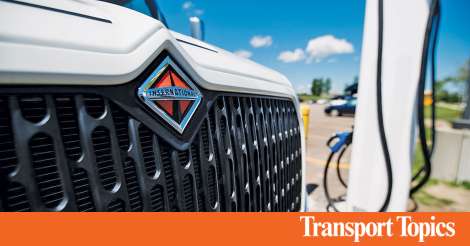Traton Maintains Battery-Electric Decarbonization Focus | Transport Topics
Traton Maintains Battery-Electric Decarbonization Focus Transport Topics


Traton Stands Firm on Battery-Electric Trucks as Best Alternative for Decarbonization

[Stay on top of transportation news: Get TTNews in your inbox.]
Introduction
Navistar parent company Traton is standing firm in its belief that battery-electric trucks are the best alternative for trucking fleets looking to decarbonize their operations, even as other equipment manufacturers invest resources in multipronged paths that incorporate multiple fueling technologies.
Sustainable Development Goals (SDGs)
- Goal 7: Affordable and Clean Energy
- Goal 9: Industry, Innovation, and Infrastructure
- Goal 11: Sustainable Cities and Communities
- Goal 13: Climate Action
Transition to Battery Electric
“We don’t see any real alternative to battery electric” when it comes to the transition away from diesel, Traton Vice President of Alternative Drivetrains Andreas Kammel said during an April 22 webinar on the outlook for BETs. “We don’t really have an ‘Option B.’”
From 2040 onward, Munich, Germany-based Traton — which also owns the global Scania and MAN brands — has pledged that the drivetrain of every truck it sells will be free of fossil fuels. Navistar sells the International brand of trucks in North America. Kammel explained that vehicle cost, cheaper energy, sustainability and infrastructure all factor into the company’s rationale.
Current Offerings
Lisle, Ill.-based Navistar currently offers one BET, the International eMV medium-duty truck. The manufacturer has more than 100 dealer locations authorized to sell and service electric vehicles — about 30% of its overall network — with more in the works, it said. Its dealerships span 41 U.S. states and seven of the 10 Canadian provinces.
Other Fueling Technologies
Traton — itself a subsidiary of global automaker Volkswagen — has just one other truck powered by a renewable fuel in its plans; MAN is planning to launch a truck with a hydrogen-fueled internal combustion engine later this year. Called the hTGX, it will be produced in a limited run of 200 vehicles.
Future Plans
For the North American market, Navistar CEO Mathias Carlbaum said at the ACT Expo last year that the company plans to introduce a Class 8 BET for regional haul applications. No further announcements on that truck have been made.
Lessons Learned and Cost Parity
Scania Group Head of E-Mobility Fredrik Allard said lessons Traton has learned so far for the nascent BET market in both the U.S. and Europe are that the trucks can cover about 217 miles (350 kilometers) on a charge and can use public infrastructure to keep charged. “It works. That is the main conclusion,” he said.
Allard told webinar attendees he also expects substantial decreases in retail BET prices during the next three or four years. He said battery-electric trucks will become more affordable as volumes increase, creating economies of scale. He projected that once BET prices fall to about twice that of diesel-powered trucks — down considerably from current levels — cost parity will be reachable as fuel cost savings make more of an impact.
Charging Infrastructure
Also vital is broad, affordable charging infrastructure, a point on which all other OEMs looking into BETs agree, Kammel said. He stressed that development and deployment of Megawatt Charging System technology could be a game changer. MCS will bring smaller and lighter batteries and shorten recharging time to be comparable with diesel, Kammel said. “It’s almost like cheating,” he quipped. While currently few in number, MCS charging stations could reach critical mass by 2027, Allard added.
Partnerships and Initiatives
“Battery-electric technology is getting better and better with each generation,” said Stefan Sahlmann, Navistar vice president of EV solutions development and activation.
Navistar in January founded a coalition alongside two of its truck maker peers aimed at educating and working with stakeholders to accelerate construction of charging and refueling infrastructure for medium- and heavy-duty zero-emission vehicles.
Powering America’s Commercial Transportation — formed alongside Daimler Truck North America and Volvo Group North America — aims to educate policymakers, regulators and other stakeholders in Washington and across the U.S. on the zero-emission infrastructure needs of the trucking industry.
European Charging Partnership
The first Milence charging site in Venlo, Netherlands. (Milence)
Traton also teamed up with Daimler Truck and Volvo in Europe to create the charting partnership Milence, which opened phase one of its first heavy-duty vehicle charging hub in the Dutch town of Venlo in December.
By 2027, Milence aims to have at least 1,700 high-performance charging points across Europe. Milence plans to open sites in Antwerp and Ghent, Belgium, in May 2024 and 2025, respectively.
Other Technologies
Traton’s charging infrastructure partners, however, are spreading their nets far and wide when it comes to the transition away from diesel. Both Daimler Truck and Volvo are investing heavily in other technologies, including fuel cell electric vehicles, hydrogen internal combustion and renewable diesel as drivetrain alternatives.
Navistar and General Motors in 2021 inked a deal to develop hydrogen fuel cell electric technology for longhaul applications. J.B. Hunt Transport Services was an initial pilot partner in that initiative.
Conclusion
Traton remains committed to battery-electric trucks as the best alternative for decarbonizing trucking fleets. With a focus on sustainability and infrastructure, Traton aims to transition away from fossil fuels by 2040. Lessons
SDGs, Targets, and Indicators
1. SDGs Addressed:
- SDG 7: Affordable and Clean Energy
- SDG 9: Industry, Innovation, and Infrastructure
- SDG 11: Sustainable Cities and Communities
- SDG 13: Climate Action
2. Specific Targets:
- SDG 7.2: Increase substantially the share of renewable energy in the global energy mix
- SDG 9.4: Upgrade infrastructure and retrofit industries to make them sustainable
- SDG 11.6: Reduce the adverse per capita environmental impact of cities
- SDG 13.2: Integrate climate change measures into national policies, strategies, and planning
3. Indicators:
- Percentage of renewable energy in the global energy mix
- Investment in sustainable infrastructure
- Per capita environmental impact of cities
- Integration of climate change measures into national policies and planning
Analysis:
The article addresses several Sustainable Development Goals (SDGs) related to the transition towards sustainable transportation and decarbonization of the trucking industry. The specific SDGs identified are SDG 7 (Affordable and Clean Energy), SDG 9 (Industry, Innovation, and Infrastructure), SDG 11 (Sustainable Cities and Communities), and SDG 13 (Climate Action).
Based on the content of the article, the following specific targets can be identified:
- SDG 7.2: Increase substantially the share of renewable energy in the global energy mix. This target is relevant as the article discusses the transition away from diesel towards battery-electric trucks, which rely on renewable energy sources for charging.
- SDG 9.4: Upgrade infrastructure and retrofit industries to make them sustainable. The article mentions the need for broad and affordable charging infrastructure for battery-electric trucks, highlighting the importance of sustainable infrastructure development.
- SDG 11.6: Reduce the adverse per capita environmental impact of cities. The adoption of battery-electric trucks can contribute to reducing air pollution and greenhouse gas emissions in urban areas, thereby reducing the environmental impact of cities.
- SDG 13.2: Integrate climate change measures into national policies, strategies, and planning. The article emphasizes the need for policy support and planning to facilitate the transition towards battery-electric trucks and the development of charging infrastructure.
The article mentions or implies several indicators that can be used to measure progress towards the identified targets:
- Percentage of renewable energy in the global energy mix: The article discusses the use of battery-electric trucks, which rely on renewable energy sources for charging, indicating progress towards increasing the share of renewable energy in the global energy mix.
- Investment in sustainable infrastructure: The article highlights the need for broad and affordable charging infrastructure for battery-electric trucks, indicating the importance of investment in sustainable infrastructure.
- Per capita environmental impact of cities: The adoption of battery-electric trucks can contribute to reducing air pollution and greenhouse gas emissions in urban areas, leading to a decrease in the per capita environmental impact of cities.
- Integration of climate change measures into national policies and planning: The article emphasizes the need for policy support and planning to facilitate the transition towards battery-electric trucks and the development of charging infrastructure, indicating progress towards integrating climate change measures into national policies and planning.
Table: SDGs, Targets, and Indicators
| SDGs | Targets | Indicators |
|---|---|---|
| SDG 7: Affordable and Clean Energy | 7.2: Increase substantially the share of renewable energy in the global energy mix | Percentage of renewable energy in the global energy mix |
| SDG 9: Industry, Innovation, and Infrastructure | 9.4: Upgrade infrastructure and retrofit industries to make them sustainable | Investment in sustainable infrastructure |
| SDG 11: Sustainable Cities and Communities | 11.6: Reduce the adverse per capita environmental impact of cities | Per capita environmental impact of cities |
| SDG 13: Climate Action | 13.2: Integrate climate change measures into national policies, strategies, and planning | Integration of climate change measures into national policies and planning |
Behold! This splendid article springs forth from the wellspring of knowledge, shaped by a wondrous proprietary AI technology that delved into a vast ocean of data, illuminating the path towards the Sustainable Development Goals. Remember that all rights are reserved by SDG Investors LLC, empowering us to champion progress together.
Source: ttnews.com

Join us, as fellow seekers of change, on a transformative journey at https://sdgtalks.ai/welcome, where you can become a member and actively contribute to shaping a brighter future.







